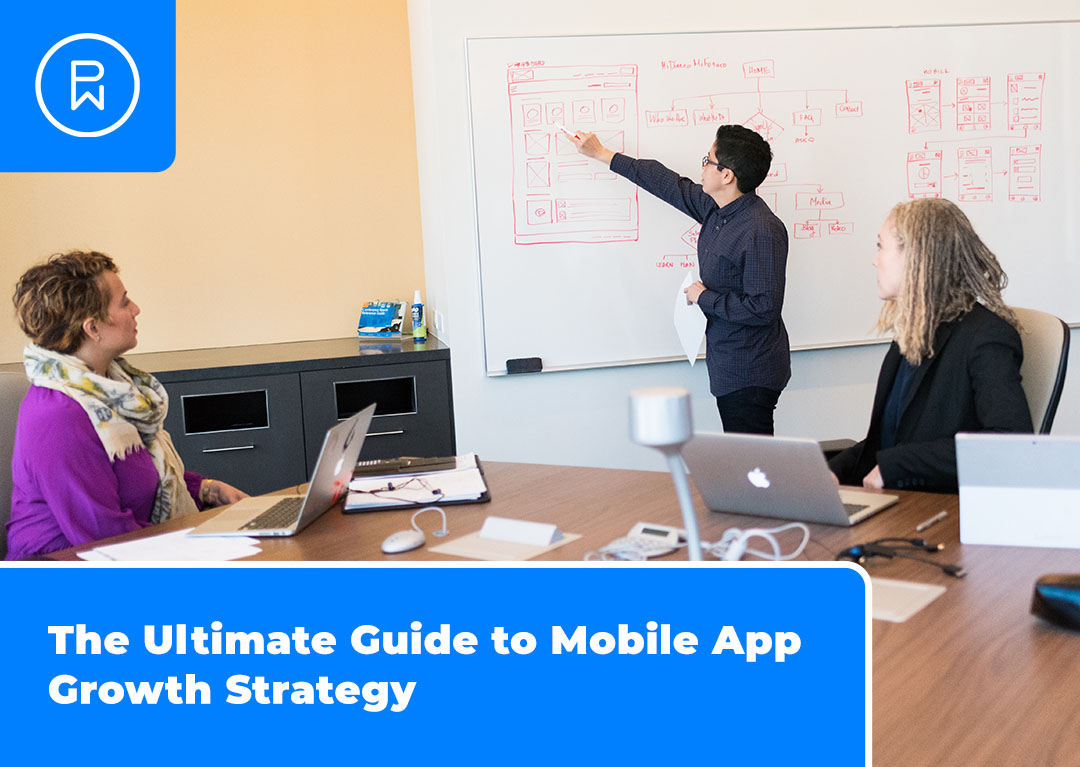Mobile apps are now an essential part of our everyday lives in today’s mobile-first world. From fitness tracking apps to social media and entertainment apps, they have become an integral part of our daily routines. However, with millions of apps available in various app stores, it’s becoming more challenging to stand out.
That’s where a solid mobile app growth strategy comes in.
Mobile app growth strategy is the set of activities, tactics, and techniques that app developers and marketers use to acquire, engage, and retain users, and maximize revenue generation. A well-thought-out strategy plays a crucial role in achieving high user acquisition and retention, and revenue goals.
In this blog post, we’ll explore everything you need to know about mobile app growth strategy. From understanding the fundamentals to tips and tactics for effectively acquiring, retaining, and monetizing users, adoption of best practices, and how to measure success.
Whether you’re a mobile app developer, app marketer, or app growth strategist, this guide will provide you with the insights and tools needed to succeed in the hyper-competitive world of mobile apps.
Let’s dive right in.
Understanding Your Audience
A successful mobile app growth strategy starts with understanding your audience. Knowing who you’re creating the app for, how they’ll use it, and what they need it to do are all essential elements of success. Here are the steps involved in understanding your audience:
The first step is conducting market research. This involves researching your target market and learning about their needs and preferences. You can do this by exploring other related apps, analyzing customer reviews and feedback, and conducting surveys and interviews with potential users.
Once you’ve gathered data from your market research, you can start to define user personas. This involves creating detailed profiles of your ideal users with information such as age, gender, location, education level, interests, and any other relevant details. This gives you a better understanding of who to target and empowers you to create a tailored growth strategy.
Evaluating user behavior is also an important part of understanding your audience. You can analyze user behavior through downloads, retention rates, in-app purchases, and more to gain insights into how users are engaging with your app and what they find valuable. Google Analytics, Flurry, and Mixpanel are examples of tools that help you to analyze user behavior.
Finally, it’s essential to use feedback to improve your app and make it more user-friendly. User feedback will give you an understanding of what users like and don’t like about your app and what features they would like to see implemented.
It can often be challenging to fully understand your audience thus, it’s essential to partner with professionals who can help you simplify this discovery process. Phunware provides full-stack mobile solutions that enable organizations to easily understand their audience and enhance their app growth strategy.
Optimizing User Acquisition
As the mobile app ecosystem continues to become more crowded and competitive, the cost of acquiring users has also been growing in recent years. It’s important more than ever to have a strong user acquisition strategy to drive mobile app growth.
Before you begin acquiring users, you need to develop a comprehensive user acquisition strategy. To do so, you should begin by setting specific, measurable goals that you want to achieve through user acquisition. For example, do you want to acquire 1000 users in the first month? Or perhaps you want to lower the cost per acquisition by 25%? Defining your goals will help you measure your progress and success.
Once you have your goals, you need to determine how you’re going to acquire users. This includes deciding which channels and platforms you will use and identifying the target demographic for each channel based on factors such as age, gender, and interests.
Implementing App Store Optimization (ASO)
App Store Optimization (ASO) is crucial in user acquisition. ASO is the process of improving the visibility of your app in stores, such as Google Play and the Apple App Store.
You can improve your app’s ranking and drive more organic downloads when you optimize your app store page by focusing on keywords, descriptions, and visuals. Identify the most relevant keywords for your app and use them in the title, description, and screenshots. You should also ensure that your visuals are clear and engaging to encourage users to download your app.
Once you have optimized your app store page, consider launching an advertising campaign to drive even more downloads. This can include running ads on platforms such as Google Ads, Facebook Ads, or Apple Search Ads.
When launching your ads, make sure you’re targeting the right audience with precise targeting options such as demographics and interests. You can also test different ad creatives to determine which one is most successful.
Phunware offers mobile advertising expertise to deliver unmatched growth and improve your ROI. From Media Planning to Campaign Optimization, we can effectively target audiences to drive strong campaign performance.
Leveraging Social Media Platforms
Social media is also a great way to acquire users. You can promote your app on platforms such as Twitter, Facebook, Instagram, and YouTube. Use visuals and videos to showcase the features of your app and encourage users to download it. You can also leverage influencers and user-generated content to reach more people.
Enhancing User Retention
Retaining mobile app users is just as important as acquiring new ones. Enhancing user retention can contribute significantly to the growth of your mobile app. It not only helps in maintaining a consistent user base but also helps in improving the app’s ranking in the app stores.
Research into global user retention rate shows that the average retention rate for iOS apps dropped from 25.6% to 4.3% over 30 days in Q3 2022 while it dropped from 22.6% to 2.6% for Android apps in the same period. If you’re an app developer, app marketer, or app growth strategist, this shows how important it is to keep users engaged with your mobile app.
The following are four vital tactics for keeping users engaged with your app:
1. Focus on User Experience
You know how frustrating it can be when an app is slow to load or the navigation is confusing. That’s why focusing on user experience is key to user retention. Make sure to use a mobile-friendly design, optimize the app for speed, and provide a streamlined navigation system. Doing these will improve the user experience and thus increase engagement and retention.
2. Implement Push Notifications
Push notifications are a great tool to engage users and keep them engaged. They can be used to alert users of new content, remind them to use the app, or offer promotional discounts. Just make sure to use them sparingly and keep them personalized. If notifications are too frequent, users may opt out or uninstall your app entirely.
Push notifications are an essential feature of mobile engagement alongside other audience monetization techniques such as direct campaigns.
3. Create In-App Personalization
Creating in-app personalization is another great way to increase user engagement. This means allowing users to customize their experience within the app. You can do this by offering personalization features for the home screen, enabling notification preferences, etc, thus giving users a feeling of control and helping to build loyalty.
4. Leverage Gamification Elements
Lastly, infusing elements of game design into the user experience encourages users to complete tasks, engage with content, and even interact with one another. Adding game elements keep users engaged and encourages them to come back to the app.
Monetizing Your App
Developing a mobile app is only the first step, the key to long-term success is monetizing your app effectively. To make your app profitable, you need to choose the right app monetization model. Below are some popular ways you can monetize your app
Implementing In-app Purchases
In-app purchases have become a significant source of revenue for many app developers and it’s a great way to keep users engaged. According to a report by Allied Market Research, the in-app purchase market is growing at a CAGR of 19.8% from 2020 to 2027 and would reach an estimated revenue of $341 billion by 2027.
With in-app purchases, users buy additional content, virtual goods, or services ranging from currency to premium content. One of the keys to successful in-app purchases is to make them timely and relevant.
Hospitality and healthcare organizations particularly can monetize their apps using in-app purchases. For example, a healthcare provider could offer premium services such as virtual consultations or personalized health plans for a fee. Similarly, a hospitality company could offer in-app purchases for additional services such as room upgrades, late checkouts, or exclusive access to amenities.
Integrating Ads
Advertising is another popular way to monetize apps. It involves placing ads in your app, either in the form of banner ads, interstitial ads, or video ads. This approach can be a great way to bring in extra revenue without requiring users to make any purchases.
However, it can also create a less-than-ideal user experience, so you should consider how intrusive the ads will be before you decide to use this model.
Offering Premium Features
Premium features are another app monetization tool. You can offer core app functionality for free but charge users for additional features, such as advanced features, unlimited access, or ad-free experiences. This monetization model works best for apps that appeal to power users and are used frequently.
Measuring and Analyzing Your Success
Measuring your app performance is essential for a successful mobile app growth strategy. Key Performance Indicators (KPIs) help you measure performance against predetermined goals and objectives and they can provide you with insights into whether your app is growing or not, and help you identify areas for improvement. Below are three important KPIs you should track:
User Engagement
User engagement is essential for understanding your app’s performance. It’s important to measure how many people are actively using your app and how often they’re returning. To measure user engagement, you can track metrics such as the average session time, the number of sessions per user, the number of daily and monthly active users, and the total time spent in your app.
The more engaging an app is, the more likely users are to spend time on it, return frequently, and recommend it to others. High user engagement leads to increased retention and revenue in the long run.
Retention Rate
User retention rates measure how likely users are to keep using your app after their first session. It’s important to track this metric as it’ll help you understand if users are finding value in your app and if they’re likely to come back. To measure retention rates, track the percentage of users who return to your app on any given day, week, or month.
App Store Ratings and Reviews
Ratings and reviews on the app store are important metrics to monitor for any mobile app. Positive ratings and reviews can help boost your app’s visibility and downloads, while negative ratings and reviews can cause potential users to look elsewhere. To analyze ratings and reviews, look for trends in the feedback and use this as an opportunity to make improvements to your app.
Refining and Scaling Your Strategy
Refining your app growth strategy can help you identify the most effective channels to promote your app, optimize your user experience, and ultimately, drive app growth. The recommended steps for refining your app growth strategy include
A/B Testing
A/B testing is a powerful tool that can help app developers and marketers improve app engagement rates. It involves creating two versions of an app, with one serving as a control and the other as the test version.
Test versions can include variations in elements such as app design, user interface, or in-app content. By observing how users interact with both versions and comparing performance metrics, you can gain valuable insights into which version works best. Some examples of A/B tests include testing different app icons, testing different call-to-actions, and testing different pricing plans.
Surveys
Conducting surveys is another essential step in refining your app growth strategy. Surveys can help you better understand your users and their needs, and how they interact with your app. This allows you to make more informed decisions about how to improve your app to better meet user needs.
You can conduct surveys using in-app or email surveys. It’s important to make sure the questions in a survey are easy to understand.
Adapting to Market Trends
Market trends are continually changing, and app developers and marketers need to be able to adapt quickly. Staying up-to-date on the latest trends enables you to stay competitive and attractive to users. You can also use market trends to identify new growth opportunities. For example, Meta introduced Stories to Instagram in 2014 and later on Facebook in 2017 to compete with Snapchat’s features.
Experimenting with New Platforms and Technologies
Exploring new avenues such as AR and VR, podcasts, and new social platforms can help you reach new audiences and attract new users. However, you should critically asses these platforms and technologies to determine which will be most effective and generate positive ROI for your mobile app growth strategy.
In conclusion, mobile app growth strategies are essential for any successful mobile app development. Understanding your audience, optimizing user acquisition, enhancing user retention, monetizing your app, and measuring and analyzing your success are key elements of a successful strategy.
Additionally, staying up-to-date with market trends, and experimenting with new platforms and technologies are important tactics for fostering mobile app growth.
At Phunware, we understand the importance of an effective mobile app growth strategy, thus we provide you with everything you need to succeed on mobile. Whether you are looking to improve your existing app or need a new one entirely, Phunware’s comprehensive mobile app solutions can deliver the technology and analytics you need to optimize your mobile app growth strategy and drive more downloads and revenue.
Chat with us today to learn more about how we can help you achieve mobile app success!







